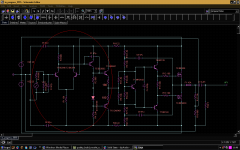The structure on your schematic does not make sense at all
This is the wrong theory 🙁
Cool , NOW you are starting to understand what this thread is really about 😱
The real purpose is to make your head (and anybody else's taking this seriously) to actually

Don't say you have not been warned 😀
yes, this is the reason im using them, i said that they tried to convice me that these 22r must be powerful ones and this would let me try without them, but i know they are perfect and if i try without them my bc560 will blow instantly, i mentioned i dont have another right now.
ok im using 128mW now look at my post #17, this is the sch im gonna use.
ok, the reason to use emitter to output i mentioned is for better handling capacitive load.
Why ? mine way shows better results.
In a simple class A stage there are resistor, not CCS. I know what is the mechanism but think its a trap.
It helps driving the capacitive load, when it's a driving emitter (like T3), not the loading one (like T10). Again - T10 does not make sense here.
In a simple class A - yes, resistor will work for the sake of simplicity. In high-quality one - dynamic load (CCS, any kind of bootstrap) will always lead to lower distortion. No exceptions. You understand why if you look at the physics of the process. Same as if you throw a stone it will fall on the ground.
Cool , NOW you are starting to understand what this thread is really about 😱
The real purpose is to make your head (and anybody else's taking this seriously) to actually
Don't say you have not been warned 😀
I know 🙂 Same as a number of other threads by the same OP.
Well, I still don't believe it's a pure trolling... but you're right... this is counter-productive 😛 I give up.
As you mentioned yes, It helps driving the capacitive load.
T3 is for charging, T10 for discharging, (yes its load this no make difference, isn't it ? )
In the first moment R of C is low and discharging starts with max current allowing more current, results in faster discharge.
T3 is for charging, T10 for discharging, (yes its load this no make difference, isn't it ? )
In the first moment R of C is low and discharging starts with max current allowing more current, results in faster discharge.
As you mentioned yes, It helps driving the capacitive load.
T3 is for charging, T10 for discharging, (yes its load this no make difference, isn't it ? )
In the first moment R of C is low and discharging starts with max current allowing more current, results in faster discharge.
No, it does not work like this. You increase the load of your follower and that's where distortion increases.
No, it does not work like this. You increase the load of your follower and that's where distortion increases.
no this is the trap here, you increase the load but this is in this little moment when this capacitor need to be discharged because the load is already heavy. you increase it a little to kill the currently heavy load (to kill more load).
This is known as "sacrifice". Everything is normal again when this cap is discharged 😎 I hope i helped you as you helped me 🙂
Last edited:
- Status
- Not open for further replies.
- Home
- Amplifiers
- Solid State
- hepl me please, need fast help


 mosfet54 - watch it!
mosfet54 - watch it!